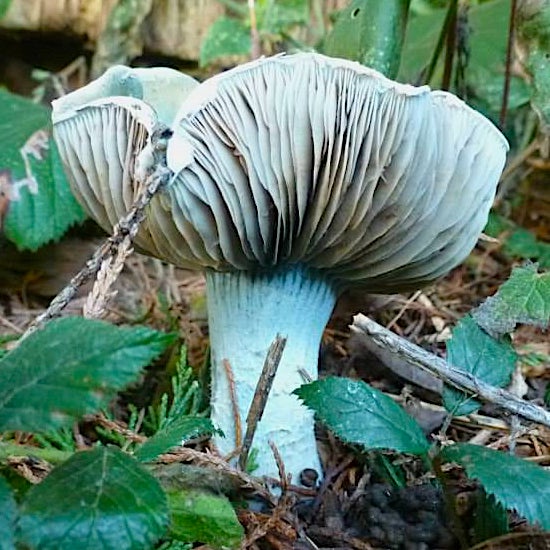
the beautiful Blue Roundhead is usually associated with summer and autumn, but might linger on into the winter.
Photo: Steve Townsend
Scientific name: Stropharia caerulea
What to look for:
- Appearance: Between 4 and 10 cm stem (stipe) with woolly white appearance and prominent ring. Blue-green cap about 3 to 7.7 cm wide and has white scales near the rim and a slimy texture. Cap is initially convex, but becomes flattened and then concave as it matures. The blue colour also fades with age to become more yellow-ish. Gills are light grey, changing to dark-ish brown, though the gill edges remain pale.
- Spores: Elliptical shape; spore print is dark purple-brown/black.
- Where: Reasonably common: found in nutrient-rich soils in grass and leaf litter. Distributed across Europe.
- When: The fruiting bodies appear from summer to autumn, sometimes persisting till early winter.
- Similar species: Verdigris Roundhead (S. aeruginosa), which is a darker blue-green.
The Blue Roundhead is a beautiful toadstool. When the fruiting bodies first appear, usually in small groups, they are a stunning blue-green colour. This is, though, definitely not an edible fungus – it contains the toxic hallucinatory chemicals psilocin and psilocybin – so is one to be admired in its natural habitat, not on a dinner plate. It is sapbrobic, meaning it gains its nourishment from dead and decaying organic matter. Look for it in humus-rich soils and leaf litter. It is relatively common, although localised in distribution, but is often confused with and misrecorded as Verdigris Roundhead.


Did you know…?
…The distinctive ring that encircles the stem (stipe) on some toadstools marks where the cap edges were originally joined as the fruiting body first emerged. After the cap extends, the ring remains, though it often disappears with age. The genus name Stropharia, from the Greek strophos for belt, refers to this feature.
…Blue Roundhead is often found in association with Common Stinging Nettle (Urtica dioica).
More information and references:
Buczacki, S., Shields, C., Ovenden, D., 2012. Collins Fungi Guide. Collins, London.
Published: December 2014
Author: Amanda Scott
Photos: Steve Townsend
